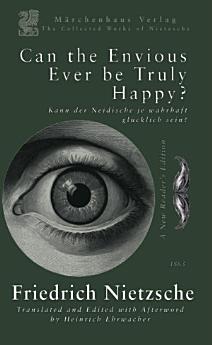Can the Envious ever be Truly Happy?: A New Reader's Edition
May 2024 · The Collected Works of Friedrich Nietzsche Book 4 · Marchen Press
Ebook
95
Pages
family_home
Eligible
info
reportRatings and reviews aren’t verified Learn More
About this ebook
A new edition of Nietzsche's rare and very short essay "Kann der Neidische je wahrhaft glücklich sein?" written in his childhood school years in September 1863 at the prestigious boarding school Schulpforta, located near Naumburg, Germany. Nietzsche attended Schulpforta from 1858 to 1864, where he received a rigorous classical education that had a significant impact on his later philosophical work. This youthful essay is a very early sketch of his robust works examining the concept of envy in relation to happiness found nested within his broader critiques of morality and human psychology including The Gay Science (1882), Beyond Good and Evil (1886), and On the Genealogy of Morals (1887). We see here a proto-materialism: "It is a sign of a vigorous nature to recognize in things an indissoluble chain of causes and effects, and not merely to believe that grain sown does not yield wheat, but also to extend the same laws to human life and the history of nations." and also an early sketch of his amoral Will-to-Power: "they hint at the terrible power inherent in his evil will. It is precisely in this legend that the deep-rooted hatred of the people against envy is revealed; in their legends and fairy tales it is not treated with jest and ridicule, like many other vices, but with deep contempt and moral displeasure." We also see early imprints of his understanding of Art and Tragedy in how he describes Envy and Love as these meta-psychological opposing forces. This is a new reader's edition of Nietzsche's early 1963 essay. This work was published posthumously in the volume "Gesammelte Werke" edited by Peter Gast (a pseudonym for Heinrich Köselitz, a close associate of Nietzsche) and Elisabeth Förster-Nietzsche (Nietzsche's sister) in 1897. It was included in the second series of these collected works under the title "Philologica," which was published in 1897 and several editions after that. This critical reader's edition presents a modern translation of the original manuscript, crafted to help the armchair philosopher engage deeply with Nietzsche's works through clean, contemporary language and simplified sentence structures that clarify his complex ideas. Supplementary material enriches the text with autobiographical, historical, and linguistic context, including an afterword by the translator on Nietzsche’s history, impact, and intellectual legacy, an index of the philosophical concepts he employs—emphasizing Existentialism and Phenomenology—a comprehensive chronological list of his published writings, and a detailed timeline of his life, highlighting the personal relationships that shaped his philosophy.
About the author
Friedrich Nietzsche (1844-1900) was a watershed German philosopher, cultural critic, poet, musician (briefly) and philologist (the study of ancient manuscripts) whose work has had a profound impact on modern intellectual history. Known for his critiques of European morality and religion (particularly Protestantism), Nietzsche's ideas on the "will to power" and the "Übermensch" have influenced a wide range of philosophical, literary, and psychological thought including thinkers such as Martin Heidegger, Albert Camus, Michael Foucault and the entire Postmodern religion.
Rate this ebook
Tell us what you think.
Reading information
Smartphones and tablets
Install the Google Play Books app for Android and iPad/iPhone. It syncs automatically with your account and allows you to read online or offline wherever you are.
Laptops and computers
You can listen to audiobooks purchased on Google Play using your computer's web browser.
eReaders and other devices
To read on e-ink devices like Kobo eReaders, you'll need to download a file and transfer it to your device. Follow the detailed Help Center instructions to transfer the files to supported eReaders.











